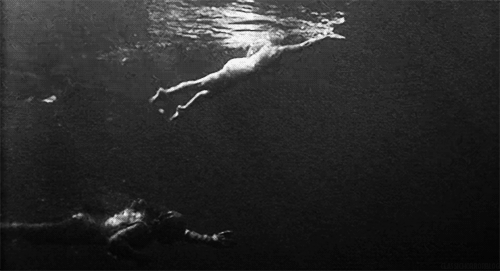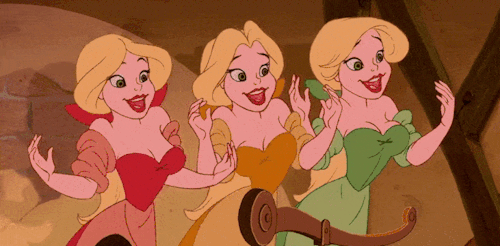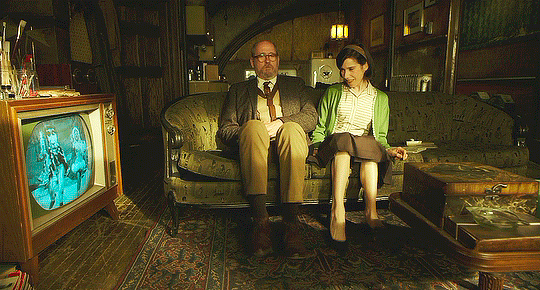
When I was a kid, I was Belle from Beauty and the Beast because I read too much, was a little weird, and loved my dad a lot. But now that I am a woman, I identify with Belle because I read too much, am a little weird, love my dad a lot, and I easily fall in love with beasts. I mean, was anyone else SUPER disappointed when Beast turned into prettyboy Adam? No one else was upset that his prettiness was her reward for falling in love with him despite his ugliness? No one noticed that her love is what changed the Beast physically, but WANTING her love is what changed him mentally? Didn't you guys watch that documentary about the hirsute man that the original Beauty and the Beast was modeled after? Why am I the only one who was upset about this?
Well, I guess I wasn't the ONLY ONE, because my favorite thing from that cocktease interview with Guillermo del Toro on NPR was that he watched The Creature from the Black Lagoon when he was a kid, and at this scene, he thought, "I hope they end up together."

The Shape of Water has a zillion great qualities that I could talk about (and will, at length, in the right setting and with the right libation), but for the sake of brevity, I narrowed it down to three.
The Shape of Water retells, updates, and combines fairy tales.
The trope of hands as they relate to communication, and how that indicates humanness is genius.
The plot is a love story. A truthy love story.
As you might have gathered, I saw The Shape of Water as a retelling of Beauty and the Beast and The Creature from the Black Lagoon. If you haven't seen Black Lagoon, I won't spoil the plot by telling you the gist: a group of scientists discover the missing, amphibious link, a monster. The monster becomes infatuated with the pretty girl, the damsel, the assistant to the hot, smart, white scientist. The monster kills or maims everyone (I think) except the protagonist couple. They make it out alive and defeat the monster. I oversimplified the plot--it is really a beautiful film. The cinematography reminded me a lot of the Weeki Wachee mermaids, and it's truly worth watching.
That said, it did come out in 1958. Del Toro's movie is set in 1962, and the premise is the same, but it's clearly for a contemporary audience.
[SPOILERS START HERE]
What's different is the slant. The villain is the hot white scientist--yes, just go on and admit it: Colonel Strickland (Michael Shannon) is hot, okay? Yes, he is. Stop fighting it. Just because he's hot doesn't make him a good person.
In fact, the protagonist is the Amphibian Man. I wondered what to call him, but because that's what he's billed in the credits, we're going with Amphibian Man. I like that choice, too, because it emphasizes his two most identifying qualities: he's amphibious. And he's a man. And you know what? He's hot, too. Yes, he is. Stop fighting it. Just because he's a beast doesn't make him not a hot person. (I can attest to this in myriad anecdotes, should you need additional, real-life evidence.) Even right after they've stolen him, as he's driving the getaway laundry van right into the front quarter panel of that decadent, teal Cadillac, Giles (Richard Jenkins) says, "He's so beautiful."
The monster isn't the same, either, obviously: we're hearing the story from a different perspective, the perspective of the damsel and her best friends. Here's another deviation from the original: Elisa (Sally Hawkins) is pretty, but she's not the traditional, final-girl, damsel pretty. She is also--as I'm sure you noticed--mute. She communicates with her hands, but she has original thought, which is not the case with our original damsel.
And another thing: Elisa has friends in this one! Oh, but they're not the bimbettes from Beauty. They're normal people, people who also have stark disadvantages in comparison to our traditional hero (but in this movie the monster). But you've probably noticed all this already. I just felt like these disparities and differences bear repeating because I love me a good retold fairy tale. Tell me that story from the perspective of the Bad Guy, yes please. Because I will accept an explanation for just about anything.

The Shape of Water is Elisa's story. But here's the thing: because she's mute, she signs. One of the first things I noticed about Sally Hawkins in this movie was her hands. You know how sometimes people's hands just stand out to you as looking very, like, capable? Like, they look so dexterous, and strong, and I'm not sure if that's a casting choice, makeup, camera angles, or some combination of them all, but Elisa's hands stand out. It makes sense, as they're her form of communication.

While we're on the topic of hands and communication, let's talk about the Amphibian Man. Elisa signs with him--she teaches him to sign, since he too cannot speak. Or at least, the language that he speaks is not understandable. Here's a thing, too...

That's some direct homage to Black Lagoon, I'd say--as many times as you see Gill Man's hands before you see HIM, no, that's a thing you can't unnotice once you see it--the hands were his precursor to his monstrosity in the prototype, and they're that way in The Shape of Water, too.
After all, the Amphibian Man uses his hands for weapons--he scratched Giles up real good when he gets scared, and let's not forget he fucking slits Colonel Strickland's throat at the end after he shoots Elisa. But while we're talking about Strickland... remember, his last words are, "Fuck. You are a god."
As viewers, we get a missing-link, magical vibe from the Amphibian Man, but I wouldn't say he was a god...magical, yes. Because he uses his hands not just as hands--although he DOES use them as hands... remember when he's messing with Elisa's collar? When they hold hands after they're shot? They are hands. But he also heals Giles' cuts with his hands. He brings his hair back. That's some real-deal magic. Loving magic, even.
But you know what doesn't come back? Strickland's fingers. FUCK ME TO DEATH--that's nasty. And the inversion of the terror that Gill Man's hands inspire in Black Lagoon is pronounced, too. In the sex scene between Strickland and his wife, while trying to keep her silent in order to fantasize that she is Elisa, he puts his rotting, gangrenous, bleeding fingers over his wife's mouth. That's a total inversion. Gill Man's hands are supposed to be scary, not the hero's! But, again, Shape of Water inverts the hero/villain dichotomy, and it's just super interesting to me that although our villain is the most normal human, his hands are the atrocious ones.

And back to the idea of "Fuck. You are a god." That's really the only line that doesn't work for me in the whole movie. It happens only just after he's come into Zelda's home and intimidated her and her husband into giving him information, and he does that by telling her the story of Samson from the Book of Judges, in which he is Samson, the hero who is on God's side. He's also tells her when he first meets her, "We were made in the Lord's image. You don't think that's what the Lord looks like, do you? He looks like me. Or you, even. But," he says, "probably more like me."
I just don't buy that Strickland would make that about-face that quickly, not when he truly believes he's in the right, which he unshakably does, painkillers and torn-off fingers, and all. His absence of workable fingers symbolizes his lack of humanity because he can't communicate the way that all the other main characters can: he can only use his voice. He also shows his lack of humanity through his lack of loving.
In case y'all didn't notice: Strickland is bad at sex. Not only because he's just pounding away fully clothed, but also because he's picturing his wife as someone else, ignoring her, and covering her mouth with his rotting and bleeding fingers. He also takes his infatuation with Elisa a step farther by intimidating and propositioning her later in the film AT WORK. I bring this up because--besides communication--we establish who's good and who's evil in this film by who's preoccupied with love.
The other evil person in The Shape of Water is the other guy who's not preoccupied with love: Zelda's husband Bruster who SUCKS. He sucks SO much. We know this from the jump because of how she playfully complains about him to Elisa at the beginning of the film. Oh, Zelda loves Bruce, but Bruce is a lazy fuck. I mean that figuratively, but it probably literally applies, too. She even tells him while she calls Elisa, "Even if you tried your whole life, you couldn't begin to understand!" which is both heartbreaking and tells the sick sad truth about heterosexual nonbestial men. In the zeitgeist of the story. Only.
Think I'm joking? Go ahead and think of the other heterosexual men in this movie. No, the Russian doesn't count, because we don't know his orientation. You got it. Pie guy. The guy with the fake southern accent who rejects Giles (Richard Jenkins, who kills, BTW), Elisa's best friend. (The nerve. What a kind man to have to suffer through that callous rejection.) And we know that Giles wants love because he feels alone after that rejection, so alone that he goes to Elisa and tells her, "I'm totally alone. You are all I have," and then they hatch a plan to steal the Amphibian Man.
Before that, though, THEY DANCE TO BETTY GRABLE TOGETHER. Y'all. There is nothing sweeter than that. I would start a family with the man who dances Bojangles' routines with me.

And the thing about Elisa is that she romanticizes all of the dancing. She taps down the hall on the way to work. In the part when she gets her voice for just a moment at the dinner table, just before the rains come, she sings that song from the 1940s movie to the Amphibian Man, so she actually gets (I think) Alice Faye's voice. Not her own. Here's what she says:
You'll never know just how much I miss you You'll never know just how much I care And if I tried I still couldn't hide my love for you. You ought to know, for haven't I told you so A million or more times. You went away, and my heart went with you. I speak your name in my every prayer. If there is some other way to prove that I love you, I swear I don't know how. You'll never know if you don't know now.
The whole scene unfolds into a 1940s/50s dance number.

It's a delight. Exactly the way love looks in the imagination of a woman who loves beasts. Sequin gown and talons. And did you notice in the beginning of the lyrics, it's a direct inversion of what Zelda tells Bruce as she calls to warn Elisa? "If you tried your whole life...." It's interesting, right? How love and communication is all that separates humans from beasts. In the zeitgeist of this movie. Only.
Because Elisa, she loves the monster, but he's a man. Look at him dance! Look at him glide! Look at him communicate! Watch how he loves! He does--he tells her so: You and me. Together.
It's interesting, right? Both the Amphibian Man and Elisa can hear, but not very many people can understand what they're saying. In fact, it seems like the only people with whom they can communicate are Elisa's coworker Zelda and her best friend Giles. She uses this to her advantage in more ways than one.
The funnest way she uses this language barrier to her advantage is pictured above, when she tells Strickland, "Fuck you," TWICE, and he doesn't understand.

Secondly, this story is told from the perspective of Giles. He says in the beginning, "What would I tell you...?" (which is another homage to the lyrics of that song, "You'll Never Know.") Eliza has him tell her story when she is upset about the prospect of the Amphibian Man being killed: she signs, You're not hearing me, and she makes him say what she signs, which he does. It's a genius way of making her listener internalize what she's saying. He has to say it in the first person. Have you ever read anything aloud that was written in the first person? Your brain internalizes the narrative. It gets into character, so to speak. It's genius both of her and of Del Toro, or whoever wrote that scene.
Later in the scene, Giles says to her, "It's not even human," and he leaves. Elisa follows him into the hall and slams her fist into the wall. He does not say what she signs. Instead, Elisa gets subtitles. She signs, "If we do nothing, neither are we." Which is also genius. (If you want to see that scene, just hit play on the video below and it should start at that scene.) That scene is the thesis of the whole movie: communication is understanding, understanding is love, and love is what makes something human. In that order. She just expanded the concept of communication and the idea of humanness.What I love most about that scene, besides the truth it shows, is that when Elisa gets subtitles, they're not in white at the bottom of the screen in a serif font that looks like an afterthought. She gets her subtitles by her face, as though she's speaking with her hands--which she is. And they're in yellow. A color that goes with the amphibious color scheme of the film as a whole.
And the lines are stacked. Their lineation is deliberate, like a poem.
It's no coincidence, either, that the movie ends with Giles reading a poem as he imagines Elisa and the Amphibian Man thriving underwater while he himself goes on alone:
Unable to perceive the shape of You, I find You all around me. Your presence fills my eyes with Your love. It humbles my heart, for You are everywhere.
I looked it up. The exact author is unknown, and so is its lineation. But isn't that interesting? It resounds without formal shape. Everyone agrees it sounds like Rumi even though he's not credited. Nonetheless, Rumi's romance poems talk about God. To everyone in the film, the Amphibian Man seems godlike. It's fitting that his poem would be formless and still make its point--and maybe the lack of the form is the point. So much of the time, the medium is the message.